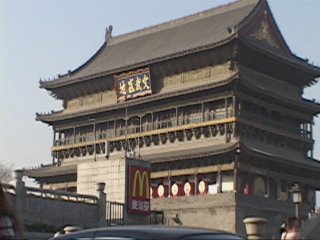 Xian was seemingly remote driving in through the dodgy night. But in the following daylight, we realize that it was in reality a metropolis of seven million people. From its central Drum and Bell Tower Square, the city’s four main arteries (East, West, North and South Street), spread out into infinity, dividing her in a logical and coherent way.
Xian was seemingly remote driving in through the dodgy night. But in the following daylight, we realize that it was in reality a metropolis of seven million people. From its central Drum and Bell Tower Square, the city’s four main arteries (East, West, North and South Street), spread out into infinity, dividing her in a logical and coherent way.The square itself is actually the rooftop of an ultra modern underground shopping mall. But above ground, it appears to be a pleasant enough grassy place, where kite flying aficionados ride the wind, or rather their kites 'ride the wind'. They themselves stay on the ground to flog their kites to unsuspecting tourists willing to throw money away for junkets that can be found in any diaspora Chinatown. The square contained the two typical Ming Dynasty towers; one museum of bells, and another a museum of drums. I couldn’t tell 1 apart from the other, but I’ll never forget the eyesore that is the Golden Arches of Big Mac precariously stuck right smack in between the two.
 The rest of the city centre is all spanking new. The locals brag that it’s only about 2 years new. This is surprising when you consider that Xian was China's ancient capital for far longer than any other city, and much longer than the recent upstart, Beijing. Most of the dynasties rose and fell here in Xian, but judging by the downtown area, they left no trace. War, progress and indifference have erased Chinese history. The centre of modern Xian could be any American city with malls, banks, KFCs, McDonalds and traffic jams. There’s so much traffic around the downtown circle (reminiscent of Rome) that the only way for pedestrians to get across was to build these space age Jetson like underground passageways.
The rest of the city centre is all spanking new. The locals brag that it’s only about 2 years new. This is surprising when you consider that Xian was China's ancient capital for far longer than any other city, and much longer than the recent upstart, Beijing. Most of the dynasties rose and fell here in Xian, but judging by the downtown area, they left no trace. War, progress and indifference have erased Chinese history. The centre of modern Xian could be any American city with malls, banks, KFCs, McDonalds and traffic jams. There’s so much traffic around the downtown circle (reminiscent of Rome) that the only way for pedestrians to get across was to build these space age Jetson like underground passageways.Xian's citizens looked prosperous and purposeful…in the downtown core anyways. This has become a world of business and careers, of mobile phones and factories. The rough and ready Tibetans of yesteryear seemed worlds away, much to the delight of both parties, I suspect. But if you look hard enough, you might still find them juxtaposition within a 15 to 20 minutes walk away still holding on to their dear turf from extinction.




No comments:
Post a Comment